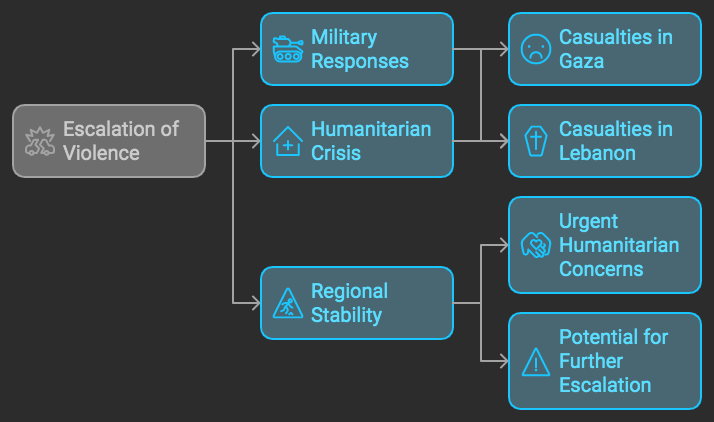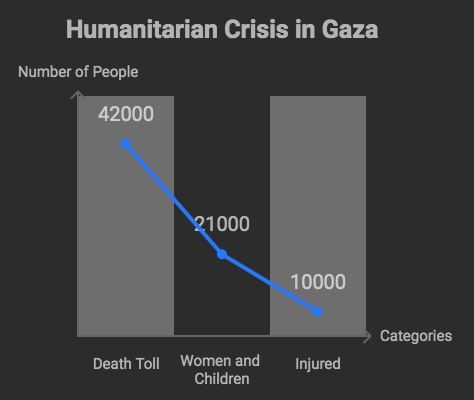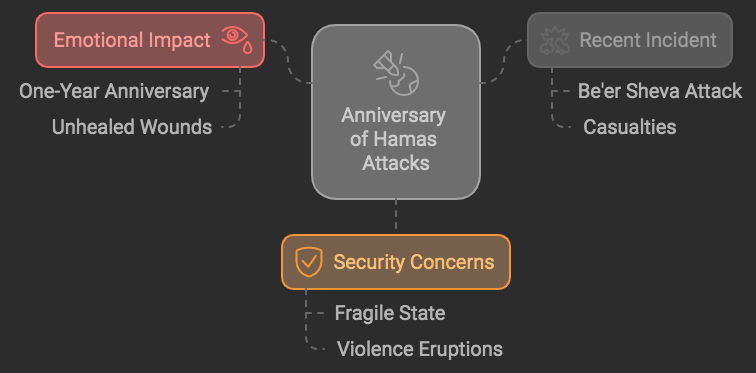This document examines the recent escalation of violence in the ongoing conflict between Israel and Hamas, coinciding with the one-year anniversary of the devastating attacks by Hamas. It details the military responses from both sides, the humanitarian crisis resulting from the conflict, and the broader implications for regional stability. The situation remains dire, with significant casualties reported in both Gaza and Lebanon, raising urgent concerns about the humanitarian impact and the potential for further escalation.

Escalation of Attacks
In the early hours of October 7, Israel launched a rapid and forceful military response to rocket fire from Hamas, stepping up airstrikes across both Gaza and southern Lebanon. The Israeli Air Force targeted key Hezbollah positions in Lebanon, including intelligence centers and weapons depots in Beirut. The intensity of these strikes resulted in massive explosions in the heart of the Lebanese capital, rattling the city and leaving behind widespread destruction. Several casualties were reported as the region was rocked by waves of air raids, raising fears of a broader regional conflict.
The strikes on Beirut are part of Israel’s broader strategy to cripple Hezbollah’s military infrastructure. These targets are believed to house vital intelligence networks and weapons storage facilities crucial to the group’s operations. Israeli officials view Hezbollah’s growing arsenal and deepening ties to Iran as an existential threat, making the dismantling of these capabilities a top priority.
A Widespread Military Offensive
Since the outbreak of the conflict, Israel claims to have neutralized over 40,000 targets, a staggering figure that underscores the scale of the military campaign. The Israeli Defense Forces (IDF) have focused on dismantling Hamas’s extensive tunnel networks in Gaza, which the group uses to transport weapons and militants. Similarly, rocket launchers and ammunition depots hidden in civilian areas have been key targets for the IDF. According to military sources, these precision strikes are aimed at limiting Hamas and Hezbollah’s ability to launch further attacks on Israeli soil.
In his latest address, Prime Minister Benjamin Netanyahu reaffirmed Israel’s commitment to an aggressive military posture, declaring that the nation would “emerge victorious” from the conflict. He emphasized that this is not merely a fight against Palestinian militant groups but part of a larger confrontation with Iran’s influence in the region. Tehran’s support for both Hamas and Hezbollah has become a central narrative in Israel’s broader strategic aims, with Netanyahu framing the military operations as a defense against Iranian expansionism.
An Unyielding Strategy
The escalation of attacks marks a significant intensification of hostilities, with both sides showing no signs of backing down. The scale of Israel’s military response, combined with the precision of its strikes, signals a determined effort to bring Hamas and Hezbollah to their knees. However, the devastating impact on civilian populations in both Gaza and Lebanon, as well as the potential for broader regional fallout, has drawn international concern.
As Israel continues to strike critical targets, the conflict remains locked in a cycle of retaliation, with neither side willing to compromise. The heavy bombardment and military actions reflect a zero-tolerance approach by Israel toward threats on its borders, particularly those backed by Iran.
Casualties and Humanitarian Crisis
As the conflict intensifies, the human toll grows at an alarming rate, with Gaza suffering the heaviest casualties. In one of the most devastating recent incidents, an Israeli airstrike hit a mosque that had become a refuge for displaced civilians. At least 24 people, including families who had sought shelter, were killed in the strike. This tragedy is only one of many, as health officials in Gaza report that the death toll has skyrocketed since the hostilities began.
According to Gaza’s Health Ministry, nearly 42,000 people have lost their lives in the conflict, many of them women and children. The constant barrage of airstrikes has left communities in ruins, with countless homes, schools, and places of worship reduced to rubble. Hospitals in the region are overwhelmed, struggling to treat the thousands of injured, while essential resources like water, electricity, and medical supplies are running dangerously low. With the conflict showing no signs of abating, the humanitarian crisis in Gaza is worsening by the day.

Lebanon Faces Rising Death Toll
The violence has also taken a severe toll on Lebanon, where the death count continues to rise amid escalating Israeli airstrikes. The Lebanese Health Ministry has reported that nearly 2,000 people have died since the latest wave of conflict erupted in late September. The relentless airstrikes have caused widespread destruction, particularly in Beirut, where recent attacks resulted in several civilian casualties, including children.
Lebanon’s infrastructure, already weakened by years of economic and political turmoil, faces further strain as the conflict escalates. The humanitarian situation in Lebanon is becoming increasingly precarious, with many citizens displaced and in need of urgent assistance. The ongoing violence not only exacerbates the existing crises but also poses a significant challenge to regional stability.
The Human Face of War
Behind the statistics of death and destruction are countless personal stories of loss and suffering. Families in both Gaza and Lebanon are being torn apart by the relentless violence. The images of children being pulled from the rubble, grieving parents burying their loved ones, and communities desperately trying to survive paint a stark picture of the human cost of this ongoing conflict.
The humanitarian organizations working on the ground warn that unless the violence subsides soon, both Gaza and Lebanon could face a catastrophe of unprecedented proportions. With tens of thousands already dead and millions more at risk, the scale of the crisis is immense. Calls for an immediate ceasefire are growing louder from the international community, but with neither side showing any signs of relenting, the road to peace remains uncertain.
Hezbollah’s Retaliation
In a dramatic turn of events, Hezbollah struck back with a missile attack on Haifa, one of Israel’s largest and most vital cities. The strike, which injured at least ten people, marked a significant escalation in the ongoing conflict. The attack on Haifa sent shockwaves through the region, not only because of the city’s strategic importance but also for its symbolic value as a bustling urban center far from the frontlines.
Hezbollah was quick to claim responsibility for the assault, declaring it a direct retaliation for Israeli airstrikes on Lebanese soil. The group’s leadership framed the attack as a response to what they view as unprovoked aggression by Israel, particularly the recent bombing campaigns targeting Hezbollah’s military infrastructure in southern Lebanon and Beirut. By hitting Haifa, Hezbollah made it clear that Israeli cities are not beyond reach and that the conflict is no longer confined to border skirmishes or isolated military targets.
Escalating Tensions
The missile strike on Haifa represents a bold move by Hezbollah, raising the stakes in a conflict that is growing more volatile by the day. In addition to the attack on the city, Hezbollah launched missiles at military installations in northern Israel, a clear signal that they are prepared to extend the battlefield. These coordinated strikes against civilian and military targets mark a dangerous new phase in the confrontation, one that could draw Israel into deeper military engagement with both Hezbollah and its backers in Iran.
For many Israelis, the attack on Haifa felt like a significant turning point, heightening fears that the conflict could spill into broader urban areas, far from the traditional hotspots along the border. Air raid sirens blared across the city, sending residents rushing to bomb shelters—a scene that has become all too familiar in this prolonged war.
A Regional Flashpoint
Hezbollah’s retaliation has not only deepened the conflict but also risked drawing other regional players into the fray. The group’s ties to Iran are well documented, and any further escalation could widen the scope of the war, potentially dragging in additional nations. For now, Hezbollah’s strike on Haifa serves as a potent reminder that the conflict is evolving rapidly, with no clear end in sight.
As tensions rise, both sides are bracing for further clashes, with Hezbollah warning of more attacks if Israel continues its military operations in Lebanon. The strike on Haifa may only be the beginning of a broader campaign by Hezbollah to pressure Israel and reassert its influence in the region, making the already fragile situation even more perilous.
Remembering October 7 Victims
The timing of the latest wave of violence carries a profound emotional weight for many Israelis, as the country marks the one-year anniversary of the October 7 Hamas attacks—a day etched in national memory as one of the deadliest in its history. The anniversary is not just a moment of reflection but a stark reminder of the deep-seated wounds that remain unhealed. Against this somber backdrop, a suspected terrorist incident at a bus station in Be’er Sheva has further rattled the nation, resulting in the death of one person and several injuries. The attack has amplified security concerns, bringing into sharp focus the fragile state of the country, where violence can erupt without warning.

As Israel mourns, the atmosphere is tense, with many fearing that more attacks could follow. For a nation already on edge, the commemoration of such a painful day serves as a sobering reminder of the ongoing threat to its security. The heightened alert comes not only from the fear of Hamas and Hezbollah but from the reality that lone-wolf attacks, like the one in Be’er Sheva, can strike at the heart of civilian life.
Calls for Ceasefire Amid Escalating Violence
While Israel grapples with its internal grief and heightened tensions, the international community is growing increasingly concerned over the humanitarian crises engulfing Gaza and Lebanon. Leaders from across the globe have voiced urgent calls for a ceasefire as the death toll rises and conditions for civilians deteriorate rapidly. In both Gaza and Lebanon, hospitals are overwhelmed, resources are running dry, and the suffering of ordinary people has reached catastrophic levels.
Despite these international appeals, there seems to be little sign of an imminent de-escalation. Israeli military operations show no sign of letting up, while Hamas and Hezbollah continue their retaliatory strikes. The situation is a volatile stalemate, with each new attack further deepening the cycle of violence. The conflict has not only become a military struggle but an enduring humanitarian tragedy, one that world leaders are struggling to mitigate as the region teeters on the edge of a broader war.
As the anniversary of October 7 passes, the memories of those lost fuel the resolve of many Israelis to see the conflict through, even as the toll on both sides grows heavier. In this moment of national reflection, the hope for peace seems distant, overshadowed by the grim reality of a conflict with no clear end in sight.
